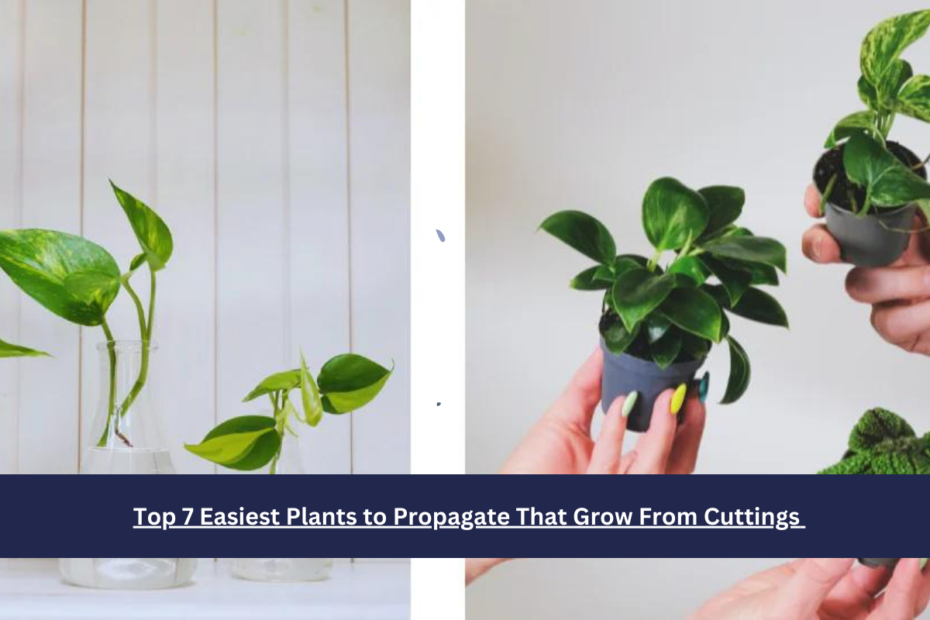Top 7 Easiest Plants to Propagate That Grow From Cuttings:Growing more plants in your garden or indoor collection can be done economically and with great satisfaction by propagating plants from cuttings. Certain plants are very simple to propagate from cuttings, which makes them great options for novices or people who want to establish new plants quickly. The following seven plants are the simplest to multiply from cuttings:
1. Epipremnum aureum
Cuttings of pothos are easily rooted in soil or water. Take a cutting that has one or two nodes (the spots where the leaves are joined), and put it straight into damp soil or into a jar of water. Pothos is a well-liked option for novices due to its rapid growth and versatility.
Maintain the cutting in a well-lit, indirect area. If propagating in water, change the water every few days; if propagating in soil, make sure the soil stays consistently moist but not soggy.
2. Chlorophytum comosum
Spider plants give birth to “babies” or offsets, which can readily split off and planted in soil or water. Just separate the offsets and put them in a soil-filled pot or submerge them in water to encourage the growth of roots.
New spider plant cuttings should be kept in well-draining soil mixture and in bright, indirect light. Although they can tolerate a lot of different environments, they do prefer some dampness.
3. Plectranthus scutellarioides
Coleus cuttings are easily propagated in soil or water. Select a cutting that has at least one node and many leaves. The cutting can be buried in soil or submerged in water. Coleus takes root quickly and grows well in a range of conditions.
Maintain a wet soil and bright, indirect light. If propagating in water, make sure to frequently replace the water to encourage strong root development.
4. Hedera helix
Stem cuttings of English ivy are a simple method of propagation. Cut a cutting that has multiple nodes, then put it in a glass of water or straight into some wet soil. Ivy is renowned for growing quickly and taking root easily.
The cuttings should be placed in an area with indirect, bright light. Transfer to soil once roots are well-established if propagating in water. Make sure the soil stays moist all the time.
5. Crassula ovata
Stem and leaf cuttings can be used to grow jade plants. When removing a leaf cutting, gently twist it off the stem and let it harden before putting it in the ground. To plant a stem cutting, take off a portion that has multiple leaves and plant it in the soil.
Before planting, let cuttings calluse for a few days to avoid rot. Jade plants like well-draining soil and bright, indirect light. Use minimal water, letting the soil dry up in between applications.
ALSO SEE:6 Fruit Seeds You Should Save And Plant To Grow Your Own Tree
6. Mentha spp
Cuttings taken slightly below a node can be used to disseminate mint easily. The cuttings can be placed straight in the ground or in a glass of water. Mint grows quickly and, once planted, can spread widely.
If the cuttings are being propagated in water, keep them in bright, indirect light and replace the water frequently. If growing in soil, make sure the soil stays damp but not wet. Mint needs regular watering and a small amount of humidity.
7.Begonia
You can reproduce begonias by cuttings of leaves or stems. To take leaf cuttings, take a healthy leaf, cut it into veined parts, and then submerge the sections in water or soil. Cut off a healthy portion of the stem and plant it in soil or water for stem cuttings.
Maintain high humidity levels and bright, indirect light for the cuttings. Water frequently, but don’t use too much. Begonias like steady moisture and a soil mixture that drains well.
These plants are excellent choices for growing your collection or sharing with friends because they are not only easy to reproduce but also forgiving. As every one has different needs, make sure to create the ideal environment for growth.
